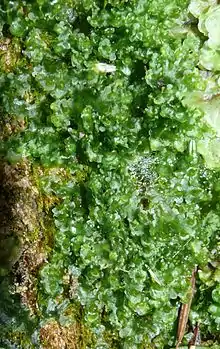Blasia
Blasia pusilla is the only species in the liverwort genus Blasia. It is distinguished from Cavicularia by the presence of a collar around the base of the sporophyte capsule, and a scattered arrangement of sperm-producing antheridia. Rhizoids and gemmae of Blasia may be parasitized by the mushroom Blasiphalia.
| Blasia | |
|---|---|
 | |
| Blasia pusilla growing on a tree in Germany. | |
| Scientific classification | |
| Kingdom: | Plantae |
| Division: | Marchantiophyta |
| Class: | Marchantiopsida |
| Order: | Blasiales |
| Family: | Blasiaceae |
| Genus: | Blasia Linnaeus 1753[1] |
| Species: | B. pusilla |
| Binomial name | |
| Blasia pusilla | |
| Synonyms | |
| |
References
- Linnaeus, C. (1753). Species Plantarum. Tomus II (1st ed.). p. 1138.
- Micheli, P. A. (1729). Nova Plantarum Genera juxta Tournefortii methodum disposita. Florence. p. 14, plate vii.
- "Part 2- Plantae (starting with Chlorophycota)". Collection of genus-group names in a systematic arrangement. Archived from the original on 6 October 2016. Retrieved 30 June 2016.
External links
| Wikispecies has information related to Blasia pusilla. |
| Wikimedia Commons has media related to Blasia pusilla. |
This article is issued from Wikipedia. The text is licensed under Creative Commons - Attribution - Sharealike. Additional terms may apply for the media files.